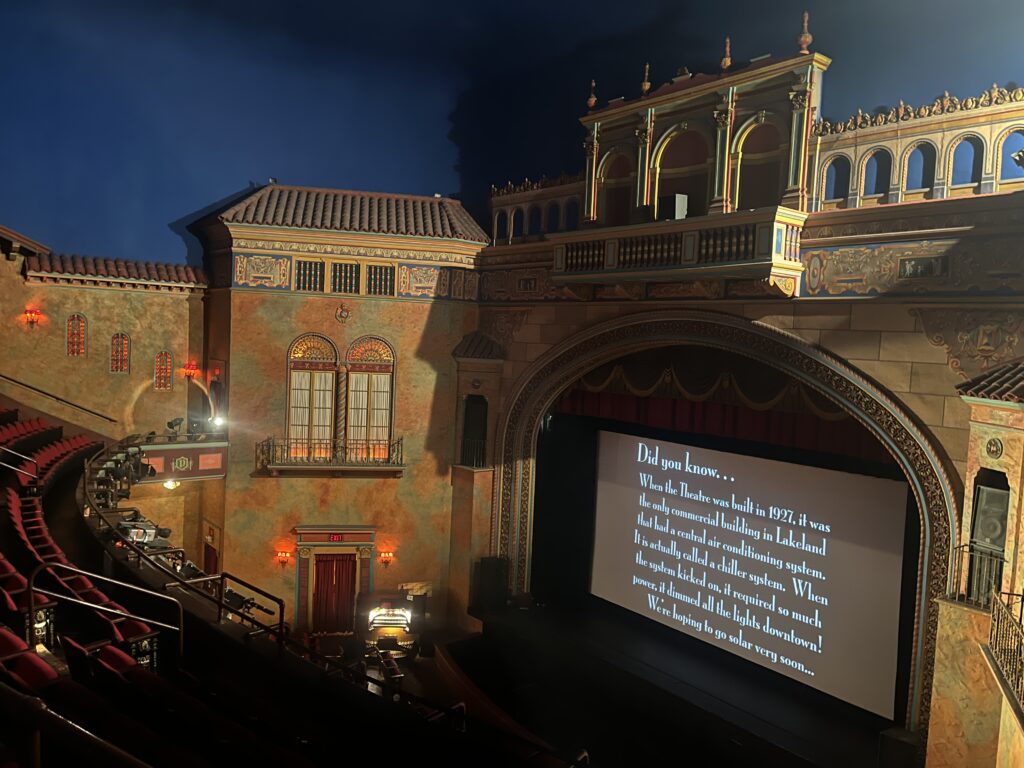
Dylan Olive
The Southern Editor
From being built 95 years ago to Elvis performing in the 50s to a major renovation, one of the only movie palaces still running in Florida is thriving.
At a time of immense optimism and faith in the United States, the Lakeland community felt a leap of hope when a vaudeville/movie palace was built in town: The Polk Theatre in 1927, which later opened in 1928.
Local businessman John E. Melton planned out the vision of his multipurpose building anchored by a movie palace, however, in a post-boom Lakeland, it was a challenge to borrow large amounts of money for new establishments. Thus, being forced to sell the incomplete theater to Publix Theatre Corporation for approximately $300,000.
Back then, Lakeland was a rural town with 15,000 residents in total. What was once called the “Melton Theatre” is located on South Florida Avenue, one of Lakeland’s busiest roads, in hopes of bringing in strong revenue to support the theater.
Lakeland’s most massive and elaborate theater was designed by the Italian-born immigrant architect J.E. Casale. Casale “recreated a Mediterranean village in the heart of Central Florida,” says the Polk Theater website. It contains 2,200 seats, surrounded by Italianate walls, windows, sconces and niches with faux balconies.
“On the outside, it looks pretty basic, but the theater itself is very pretty,” freshman Aidan Armes said. “It looks like you’re inside of a picturesque little village, and there are stars painted on the ceiling and there are windows and balconies. It’s really cool.”
Possibly the most astonishing part of this theater is the deep royal-blue ceiling. What fascinates people is the twinkling stars that give a sunrise-sunset effect. Due to its naturalistic motif, the theater is considered to be an “atmospheric” theater.
With the Polk being designed by an Italian architect, it allows Lakeland residents to get a glimpse of an outside country while still in their hometown. Getting the opportunity to see Italian villas is not something that many predict happening in their lives, yet is possible if they step foot into this theater.
At the time, there were multiple features of the theater that made it highly impressive to most others. One was the 100-ton air wash system, which kept the theater chill. It was so powerful that when it was first built, it caused lights to go out all across when turned on, draining a significant amount of the power supply. In its earlier years, an operator had to turn it on and off. It would sometimes get too cold, so an usher had to rush down to the basement and shut down the system.
The Polk thrived in its first 20 years. From the introduction of “talkies” in the 20s to the rise of the television medium, there was always something showing at the theater, especially since there were more than just screenings.
“Vaudeville acts, newsreels and various civic functions also drew crowds to the Theatre,” says its website. The vaudeville acts were popular until the early 30s, and featured burlesque performances, acrobats, comedians, magicians and more. There’s a stage trap door that was most useful for magic acts.
Many stars throughout history performed live at the Polk, including The Chinese Houdini, Li Ho Chang, Sally Rand, Gene Autry, Harry James, Gene Krupa, Glenn Miller, Tommy Dorsey, Eddy Arnold and Tom Mix. In August 1956, the legendary Elvis Presley performed three shows at the theater with accompanying acts Ray Brankey, Frankie Connors, Nancy Ford, the Jordanaires and comedian Phil Maraquin. This would be their last ever time touring Florida.
The 40s were the end of the Polk Theatre’s “golden years.” In 1957, movie attendance dropped 50% of the historically high turnouts in the mid-1940s. With the popular rise of televisions, living rooms replaced movie theaters across nations as many of them closed in effect. But, due to World War II and the depression, the theater served as a town center for community interaction.
Young people were a magnet to the theater, as many teens and young adults would come to sit under the stars on the balcony while watching a film—quite the romantic setting, at least for Lakeland at the time. “Many long-term Lakeland relationships first began under the blue, twinkling ceiling of the Polk Theatre,” its website says.
The suburb-filled Lakeland that is known today started coming around in the 60s and 70s with more homes and businesses being built. By the 1980s, the theater’s downtown location became a district liability, causing a push for closure since televisions and more functional theaters were more accessible.
A concerned group of citizens came together and created a non-profit group called Polk County Landmarks, now Polk Theatre, Inc. Together, they secured loans and grants and purchased the theater for $300,000 in 1982. In 1999, the theater underwent a major restoration and is now listed under the National Register of Historic Places.
“I’m not really shocked that it’s still around,” Armes said. “I feel like smaller towns like to keep certain buildings around to preserve history, also, it’s a cute little building that stands out from the other more modern buildings in downtown Lakeland.”
To this day, the Polk Theatre is still a non-profit, relying on donations and grants to stay open and meet its financial obligations. The theater is supported by “revenue from films, its Performing Arts Series, two fundraisers a year, rental income and memberships,” says its website. Some supporters of the Theatre include the City of Lakeland, the Terrace Hotel, The Ledger, Publix Supermarket Charities and the RP Funding Center.







